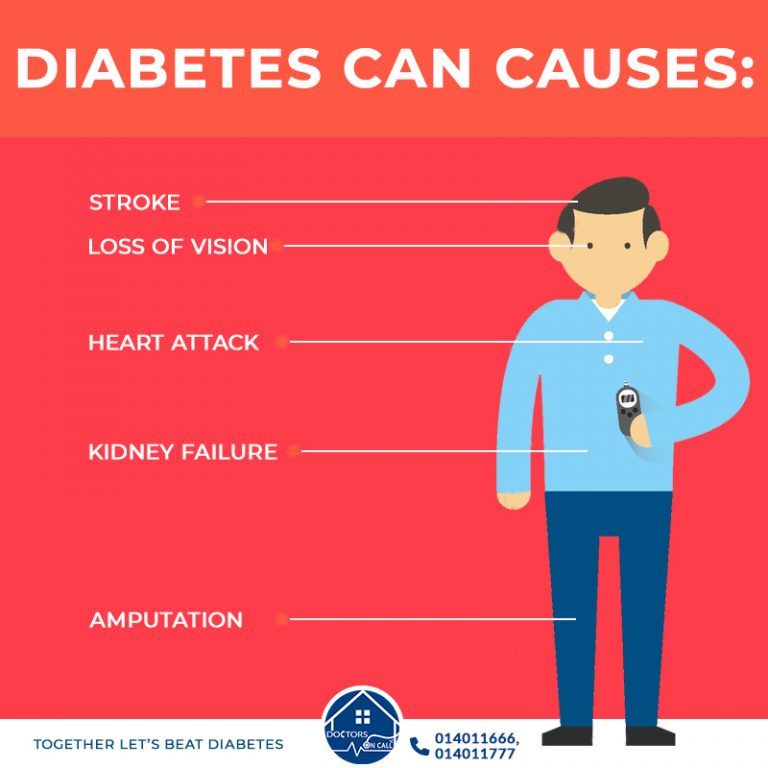Diabetes (मधुमेह) is a heterogeneous group of metabolic disorders in which there are high blood sugar level over a prolonged period. Diabetes is due to either the pancreas not producing enough Insulin or the cells of the body not responding properly to Insulin.
In a normal human body, Insulin (a hormone produced by the pancreas) controls the blood glucose levels. After a person takes a meal, blood glucose elevates and thus insulin is released from the pancreas to cancel out the glucose level by encouraging the uptake of glucose into body cells. But in diabetic patients, the absence of sufficient production of Insulin or lack of response to Insulin results in an abnormality in blood sugar levels. Diabetes is a chronic medical condition and it lasts a lifetime, however, diabetes can be managed with healthy lifestyle and proper diet management.
TYPES
- Type 1 Diabetes
Previously, referred as Insulin Dependent Diabetes Mellitus (IDDM) or Juvenile Diabetes is the state where pancreas fails to produce enough Insulin. Patients with TYPE 1 Diabetes must monitor their blood glucose levels regularly by carrying out regular blood tests and will need to take insulin for rest of their life.
Cause: Unknown.
- Type 2 Diabetes
Approximately 90% of all diabetes cases are TYPE 2.
It begins with Insulin resistance, a condition in which cells fail to respond to insulin properly. As disease progress lack of Insulin may develop. This form was previously referred to as Non-Insulin Dependent Diabetes Mellitus (NIDDM) or adult-onset diabetes. Being overweight, lack of physical activities, unhealthy eating habits all contribute to the risk of development of TYPE 2 diabetes.
- Gestational Diabetes
It occurs when pregnant women without a previous history of diabetes develop high blood sugar levels. This type of diabetes affects females during pregnancy and can be controlled with exercise and proper diet management. Uncontrolled gestational diabetes can increase the risk of complications during childbirth and abnormality in the child.
SIGNS & SYMPTOMS
- Polydipsia (Increased thirst)
- Polyphagia (Increased hunger)
- Lethargy, fatigue
- Blurred vision
- Breath: the smell of acetone (fruity smell)
- Unexplained weight loss
- Hyperventilation (Kussmaul breathing)
- Gastric: Nausea, vomiting, abdominal pain
- Polyuria (frequent urination)
- Glycosuria: characterized by an excess of sugar in the urine
- Slow healing of cuts & wounds
- Itchy Skin
- Dry mouth
Note: Symptoms may develop rapidly from week or month in Type 1 Diabetes.
Symptoms may be much slower or absent in Type 2 Diabetes
CAUSES
Body failing to produce sufficient insulin or inability of the cells to use insulin properly and efficiently leads to diabetes.
- High blood pressure
- Increasing age
- Genetic
- Family history
- Ethnicity
- Environmental & lifestyle
- Overweight, obesity & lack of
- physical activity

COMPARISION OF TYPE 1 & TYPE 2 DIABETES
| FEATURE | TYPE 1 DIABETES | TYPE 2 DIABETES |
|---|---|---|
| Onset | Sudden | Gradual |
| Age at onset | Mostly in children | Mostly in adults |
| Body Size | Thin or normal | Often obese |
| Ketoacidosis | Common | Rare |
| Autoantibodies | Usually present | Absent |
| Endogenous Insulin | Low or Absent | Normal, decreased or increased |
| Concordance in identical twins | 50% | 90% |
| Prevalence | ~10% | ~90% |
DIAGNOSIS
According to the current definition, two fasting glucose measurements above 126 mg/dl (7.0 mmol/l) is considered as diagnostic for Diabetes
| Condition | 2 Hours Glucose | Fasting Glucose | HbA1c | |||
|---|---|---|---|---|---|---|
| Unit | Mmol/l | mg/dl | Mmol/l | mg/dl | mmol/mol | DCCT% |
| Normal | <7.8 | <140 | >= 6.1 | <110 | <42 | <6.0 |
| Impaired fasting glycaemia | <7.8 | <140 | >= 6.1 | >=110 | 42-46 | 6.0-6.9 |
| <7.0 | <126 | |||||
| Impaired Glucose tolerance | >=7.8 | >=140 | >=7.0 | >=126 | 42-46 | 6.0-6.4 |
| DM | >=11.1 | >=200 | >=7.0 | >=126 | >=48 | >=6.5 |
PREVENTION
There is no known preventive measure for TYPE 1 Diabetes.
Type 2 Diabetes can be often be prevented or delayed by maintaining
- Normal body weight
- Engaging in physical activities
- Consuming a healthy diet
- Limiting sugary beverages
- Eating less red meat
- Smoking cessation
DIABETIC EMERGENCIES
Hypoglycemia: low blood sugar in common in persons with TYPE 1 & TYPE 2 Diabetes.
Effects can range from mild cases to more serious cases
Mild/Moderate Cases
- Sweating
- Uneasy feeling
- Trembling
- Increased appetite
- Rapid breathing
- Cold
- Pale skin
Serious Cases
- Confusions
- Changes in behavior such as aggressiveness, seizures, unconsciousness


Recent Comments